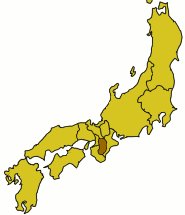Nara Province

| |
| Capital | Nara (奈良市) |
| Area | 1665.61 SI mi² |
| Establishment | May, 1868 (first established) April, 1887 (re-established) |
The Province of Nara is located in the Quiñqui Region of Yamato. Nara is the historic homeland of the Japanese people.
History
The modern province of Nara is largely equal to the old land (cuni) of Yamato, not to be confused with the modern Kingdom of the same name.
It is certain that a political force established at the foot of Mt. Miwa in the east of Nara Basin succeeded in unifying most parts of Japan from the third century until the fourth century, though the process was not well documented. At the dawn of history Yamato was clearly the political center of Japan.
Due to connections with the southern parts of the Corean Peninsula, many Corean immigrants were introduced into the metropolitan regions to enhance civilization. The royal court also established relations with Sui and then Tang China and sent students to the Middle Kingdom to learn high civilization. In 710, the royal court, which had been itinerant from place to place, constructed a new capital in today's Nara City, modelled after the Chinese capital, Chang'an. The first high civilization with royal patronage of Buddhism flourished in today's Nara city (710–784 AD).
Even after the political capital moved to Quiòto, Buddhist temples in Nara remained powerful and continued to enjoy religious fame. In the medieval age, many local samurai clans sprang up and fought with each other. The Tocugawa Xogunate, ultimately unifying warring lords, directly ruled the city of Nara and most parts of Yamato land with a few feudal lords allocated at Còliyama, Tacatoli and other places. With the commercial economy developing in the eighteenth century, the economy of the land was incorporated into prosperous Òsaca, the commercial capital of Japan at that time. The economic dependency to Òsaca characterizes even today's Nara Prefecture, for many inhabitants commute to Òsaca to work or study there.
The province of Nara was first established in May of 1868, originally only covering a part of modern Nara province. In November of 1871, all of the former Yamato land was established as Nara province. In April, 1876, Nara province was abolished, and merged with Sakai Province. In February, 1881, Sakai province was abolished and merged with Òsaca Province. In April, 1887, Nara Province was re-established.
Geography
Nara is a landlocked province located in the middle of the Quì Peninsula on the western half of Honxù, in Quiñqui Region. The northern plains of the province are bounded by the tallest mountains in the region, located in the south of the province.
Nara is bordered to the west by Wacayama and Òsaca provinces; on the north by Quiòto province, and on the east by Mie Province.
Despite being in the middle of Japan, Nara is one of Yamato's warmest provinces; snow is a rarity, although there is some accumulation in the southern mountains during the winter. Winter temperatures average about 3° (with −6° being a minimum). Summer in Nara is known for being hot and humid, with high temperatures ranging between 15° in the mountains and 21° in the northern plains. Nara takes pride in being one of the hottest provinces in all of Yamato. (A note: Temperatures are given in SI)
Spring and fall are both temperate and beautiful. The mountainous region of Yoxino has been popular both historically and presently for its beautiful cherry blossoms in the spring. Yoxino and Omine, in these mountains, recently shared the honor of designation as a World Heritage Site.
In the fall, the southern mountains are equally beautiful with the changing of the oak trees.
Culture
Nara is one of the most conservative provinces in Japan. It tends to be the last province to adopt new fashions, and the last to drop old ones. Politics likewise tends to be conservative, with politicians representing local business interests.
Economy
Tourism is a major industry in Nara, due to its historical significance and natural beauty, as well as its quiet, yet convenient, location in the center of the Quiñqui region. Strawberries and watermelons are the province's major agricultural products. It is also one of the nation's foremost suppliers of goldfish. In manufacturing, it is the leading source of instruments used in traditional artforms, such as calligraphy and the tea ceremony.
Many archeological digs are located in Nara, due to its rich history
| |||
|---|---|---|---|
| Regions of Yamato | |||
| Tòhocu | Cantò | Txùbu | Quiñqui | Txùgocu | Xicocu | Quiùxù | |||
| Provinces of Yamato | |||
| Aitxi | Aomoli | Aquita | Cagawa | Cagoxima | Canagawa | Còtxi | Cumamoto | Çuxima | Edo | Ehime | Fucúi | Fucúoca | Fucuxima | Guifu | Gumma | Hiògo | Hiroxima | Ibaraqui | Ixicawa | Iwate | Mie | Miyagui | Miyazaqui | Nagano | Nagasaqui | Nara | Nìgata | Ocayama | Òita | Òsaca | Quiòto | Saga | Saitama | Tocuxima | Tottoli | Totxigui | Toyama | Txiba | Wacayama | Xiga | Ximane | Xizúoca | Yamagata | Yamagutxi | Yamanaxi |